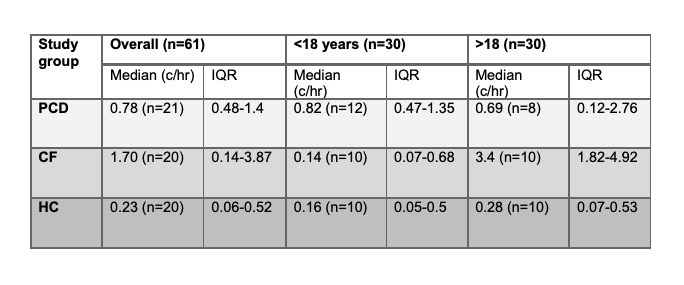Abstract
Background: Primary Ciliary Dyskinesia (PCD) is a rare disease leading to recurrent respiratory tract infections and bronchiectasis. Robust objective measures of disease surveillance are required.
Methods: Night-time cough frequency (coughs per hour (c/hr)) was reported in adults and children attending Leeds teaching hospitals. Individuals with PCD (n=23) were compared with pre-modulator CF (CF, n=27)) and healthy controls (HC, n=21) at baseline health and during and after significant respiratory exacerbations requiring intravenous antibiotics.
Results: Adults with CF had a higher baseline cough frequency (3.4c/hr) when compared to adults with PCD (0.69c/hr) and HC (0.28c/hr). Children with PCD had higher baseline cough frequency (0.82c/hr) than children with CF (0.14c/hr) and HC (0.16c/hr). A decrease in cough frequency between the start of exacerbation and 4 weeks post treatment were observed in both the PCD and CF groups (4.3c/hr to 1.05c/hr for PCD and 3.98c/hr to 1.43c/hr for CF).

Table: Median baseline cough frequency, measured as c/hr
Conclusion: These findings highlight differences in night-time cough frequency between PCD and CF. Night-time cough frequency surveillance has the potential of being a practical and objective marker of response to treatment and an early detection tool which could enable prompt intervention.